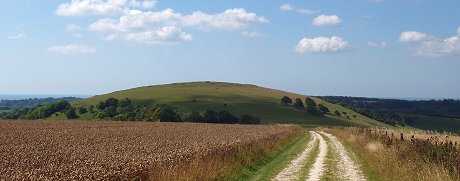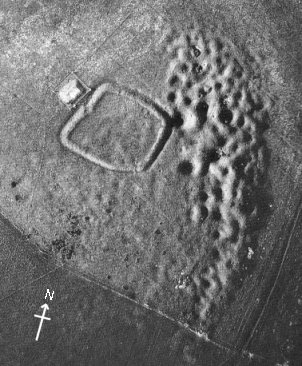 The word "Harrow" is
believed to have been derived from the old Anglo-Saxon word "Hearg" which today
we would translate as a "heathen shrine".
The word "Harrow" is
believed to have been derived from the old Anglo-Saxon word "Hearg" which today
we would translate as a "heathen shrine". (Part 1, Chapter 2, Section 2) ( Bk. Index )
In the far north of the parish of Angmering, Harrow Hill can be found
(Map Reference: TQ082100), wrongly stated by many professional and academic
bodies to be situated in Patching. Harrow Hill is the location of an ancient
hill fort, and flint mines worked from Neolithic times.
 The word "Harrow" is
believed to have been derived from the old Anglo-Saxon word "Hearg" which today
we would translate as a "heathen shrine".
The word "Harrow" is
believed to have been derived from the old Anglo-Saxon word "Hearg" which today
we would translate as a "heathen shrine".
There has been human activity on Harrow Hill since Neolithic times, as many of the flint mines on the hill date from that era, and certainly activity there during the Bronze Age, Iron Age, Roman and Saxon periods. Many animal bones, flint chippings, axeheads, and even a roman coin have been found during excavations.
The earliest mining method was likely to have been by extracting flints
from the near surface (open cast quarrying), and tools may have consisted
largely of deer horns and large animal bones. As tools became more
sophisticated during the Bronze and Iron Ages, mining went to far greater
depths. Well over 200 mining sites have been identified on Harrow Hill. Of the deeper workings, one of the earliest excavations of the hill
by E and EC Curwen in the 1920s and 1930s found one shaft with a depth of over
22 feet and having six galleries leading from it. Radio carbon dating of a
shaft from another excavation in 1994 (Felder) suggested the shaft had been cut
at the end of the fourth century BC, which would make Harrow Hill one of the
earliest known shaft flint mines.
Of the deeper workings, one of the earliest excavations of the hill
by E and EC Curwen in the 1920s and 1930s found one shaft with a depth of over
22 feet and having six galleries leading from it. Radio carbon dating of a
shaft from another excavation in 1994 (Felder) suggested the shaft had been cut
at the end of the fourth century BC, which would make Harrow Hill one of the
earliest known shaft flint mines.
The hill fort was not large and is dwarfed by Cissbury fort not far away, probably the second largest in the UK. Harrow hill fort is probably late-Bronze Age and, unusually, is virtually square in shape. Hill locations of this type were often the sites of Roman or Saxon temples ("heargs") and perhaps this is how the hill obtained its name (see above). The banks of the fort appear to have been only 5 foot high but little or no evidence has been found of actual occupation unlike the close-by Bronze Age enclosure on New Barn Down (a SE spur of Harrow Hill) where a few palisade post holes have been found during excavations as well as post holes from roundhouse dwellings. However, ancient flint miners may have used the mine shafts as dwellings for a period as there is some evidence of charcoal burning, but this could have resulted from the flint tool making process.
No burial sites have been found on Harrow Hill itself, but a couple of burial barrows are to be found less than a mile to the west on Barpham Hill and an even nearer one on New Barn Down.
Many excavations of Harrow Hill have been performed over the years and those wanting detailed information, photos, diagrams, bibliography, etc, can find out more by consulting David Staveley's excellent Sussex Archaeology and Folklore page relating to Harrow Hill by clicking here.
Neil Rogers-Davis,
July 2005
( Page first uploaded: 27 July 2005 )